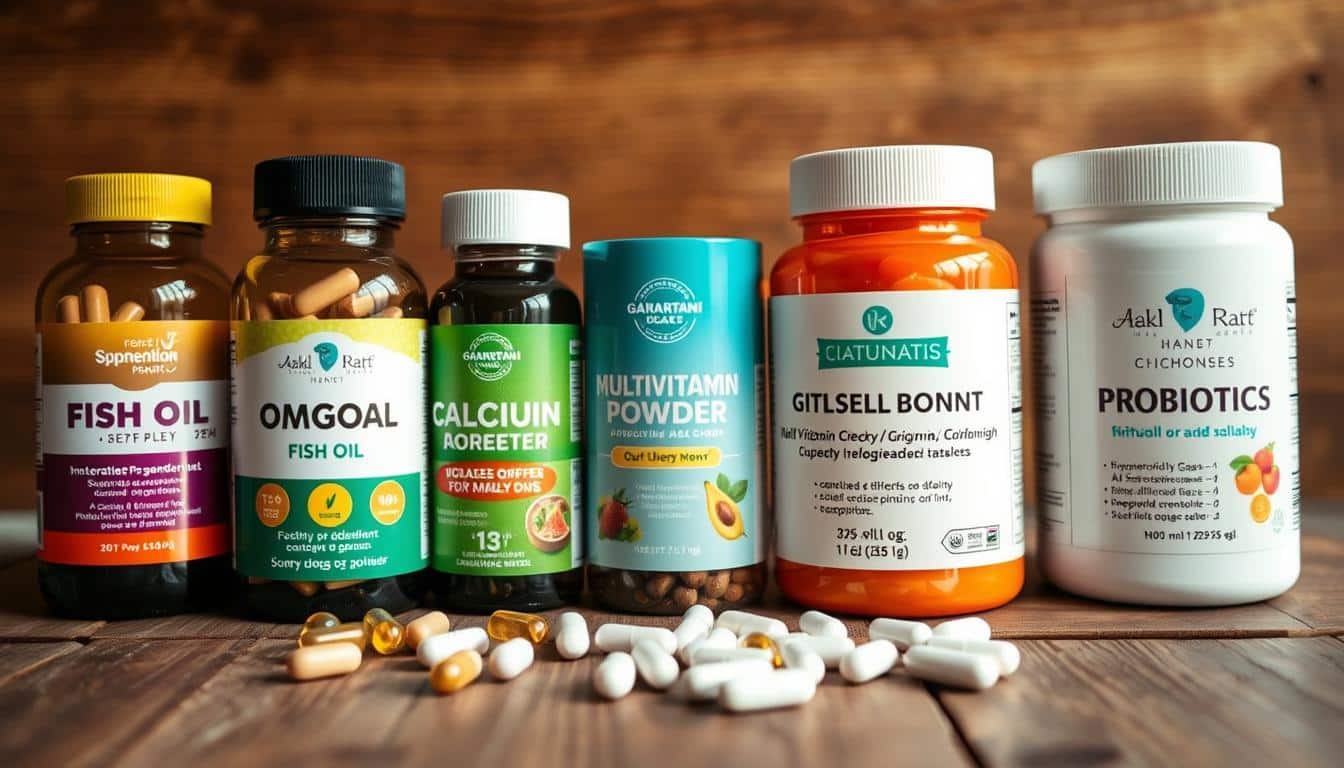Many pet owners trust vets from Banfield, VCA, or local clinics to find allergies. Still, it’s powerful to learn reading dog food labels on your own.
Finding the cause of dog allergies means knowing which ingredients can cause issues. This includes proteins, carbs, fats, and additives that might lead to itching, ear infections, or tummy troubles.
This guide helps you understand dog food labels. It shows why the order of nutrients on labels is important. This is true for brands like Purina, Hill’s, Royal Canin, and Iams.
Labels also reveal preservative types, helpful probiotics like Lactobacillus acidophilus, and vitamins and minerals. These details are key for your dog’s health and immunity.
Simply put, learning how to spot allergy-causing ingredients in dog food helps. It makes talks with your vet better and helps find safe food faster during elimination diets or for long-term care.
Understanding Canine Allergies and Why Ingredients Matter
Allergy issues in dogs can leave owners feeling puzzled. Knowing about canine allergies can help spot problems and connect them to diet or surroundings. Reading what’s in their food offers hints about what might be causing issues. This helps when talking to your vet.
Overview of common allergy types in dogs
There are four main allergy groups in dogs: environment, food, fleas, and contact. Pollens, dust, and molds cause many environmental allergies. These can make dogs itch all the time or just in certain seasons. Food issues often come from proteins like beef or chicken, sometimes after eating the same food for a while.
How allergies affect skin, ears, and digestion
Dogs with allergies might scratch a lot, lose hair, or get darker, thicker skin. Atopic dermatitis usually starts in younger dogs and gets worse if not treated. Ears can get sore or infected. Around thirty percent of dogs with food issues can throw up or have diarrhea. Itching often happens on the feet, face, belly, or around the tail.
Why ingredient reading supports diagnosis and management
It’s important to read food labels closely if your dog has food allergies. The ingredients can tell you about proteins, additives, and preservatives that might cause reactions. Keeping detailed notes on your dog’s diet helps your vet with tests to figure out the problem. Clear food labels help pick the right food and avoid allergy triggers.
- Keep a list of every food, treat, and supplement given.
- Note storage methods and any recent brand changes.
- Share ingredient lists with your veterinarian for targeted testing.
How to read ingredients for dog allergies
Figuring out a pet label can be tough at first. Just start with the basics: ingredients are listed from heaviest to lightest. The first things on the list usually show what the food mainly consists of. Learning to read dog food labels helps you choose diets for allergy tests and everyday care.
Notice how the order of ingredients in dog food focuses on proteins and carbs. The first four or five items are crucial for figuring out an elimination diet. If beef or chicken is listed early, those proteins are probably a big part of the dog’s diet.
Ingredients list order and what it means
- Ingredients go from heavy to light. Water and fresh meat make some items weigh more. Look at the guaranteed analysis for a full picture.
- Check the first five ingredients. They show what your dog is mostly eating and help pick new proteins like venison or rabbit.
- Be on the lookout for manufacturing warnings about shared facilities; they might add unexpected proteins.
Interpreting protein sources, meals, and by-products
- Whole muscle meat gives lean protein. Meat meal is concentrated protein with less moisture. See which provides more nutrients and protein.
- By-products are organs and bits that have vitamins and minerals. They’re not necessarily bad, but can cause issues for some dogs.
- Hydrolyzed proteins and new sources are mentioned if used. They help avoid immune system reactions and are good for vet-supervised diets.
Spotting hidden allergens and flavorings
- Be wary of terms like animal digest and meat by-products; they hide specific proteins and are potential allergens.
- Flavored things in treats and pills can mess up a food trial. Look for these additives in medicines and treats.
- Storage mites and dirt in dry food can be allergens. Change how you check and store food to lessen exposure.
When you’re unsure, show the labels or pictures to your vet. Reading labels and paying attention to the order of ingredients helps make food trials more accurate. This reduces surprises in an elimination diet.
Key nutrients and ingredients to evaluate on labels
When you’re choosing what to feed your dog, reading labels is key. It helps you find food that meets their specific needs. Pay attention to the protein, carbs, fats, vitamins, and minerals. Small changes in these can help with your dog’s skin, digestion, and overall health.
Proteins: quality, source, and potential allergens
- The first ingredients listed tell you about the main proteins in the food. Look for beef, chicken, lamb, fish, or soy.
- Whole meats offer complete amino acids. Meat meals pack in protein, while by-products’ quality can vary, often including organs.
- Some dogs are allergic to beef, dairy, or chicken. Consider unusual proteins like rabbit or venison for these dogs.
- Hydrolyzed proteins are broken down to prevent allergies. They’re usually found in prescription diets.
Carbohydrates and fiber that affect gut health
- Carbs in dog food come from grains like rice or non-grains like peas.
- Different fibers, such as beet pulp or chicory root, feed good gut bacteria.
- Getting the right amount of fiber is crucial. It helps with stool quality without causing food sensitivities.
Fats, omega fatty acids, and inflammation
- Fats provide energy and help absorb vitamins. Look for specific fats like chicken fat, instead of just “animal fat.”
- Omega-3, found in fish oil or flaxseed, reduces inflammation. It’s good for your dog’s skin, joints, and brain.
- Omega-6, from chicken fat or soybean oil, is also important. But, it’s crucial to balance it with omega-3 to avoid inflammation.
Vitamins, minerals, and water content
- Make sure dog food includes essential vitamins and minerals like Vitamin A, calcium, and more to support health.
- Home-made or plant-based diets should follow AAFCO standards. This ensures they don’t miss important nutrients.
- The moisture in dog food varies. Wet food has more water, which can help dogs with certain health issues stay hydrated.
- Also, check for important amino acids such as taurine. It’s crucial for some breeds and life stages.
Ingredients to avoid or watch for with allergic dogs
Reading labels is key to identifying items that could cause allergies. Be mindful of all ingredients, seen and unseen, when picking food, treats, and toys that touch the mouth.
Toxic and commonly reactive ingredients
Some foods are downright dangerous. For example, garlic can be toxic to dogs, harming their red blood cells. You should never feed your dog chocolate, avocado, certain nuts, or too much citrus.
Beef, chicken, dairy, wheat, soy, eggs, and pork are also problematic. Dogs often have allergies to multiple proteins. So, make sure to list every protein found on product labels during an elimination trial.
Fillers, contaminants, and cross-contact risks
Fillers like beet pulp and cellulose are added for fiber. They might be helpful, but it’s important to know whether they’re nutritional fiber or just empty calories. Terms like meat meal, animal digest, and composite may hide real allergens.
Shared manufacturing lines or storage mites in bulk bins can lead to cross-contact in dog food. Always read the manufacturer’s statements and lot information to lessen the risk of contamination during an elimination diet.
Preservatives and additives that may irritate sensitive dogs
Artificial preservatives such as BHA, BHT, and ethoxyquin are common on labels and can bother sensitive pets. Try finding brands that opt for natural preservatives, like mixed tocopherols or ascorbic acid.
Eliminate flavored medications, dental chews, pill pockets, and treats when trying a new diet. Unseen flavorings and additives can mess up a food trial without you realizing it.
- Check for raw ingredients that risk Salmonella or E. coli and prefer fully cooked options.
- Verify single-protein and prescription diets for stricter ingredient control before starting trials.
- Keep a running inventory of all household items that might contain food flavors or allergens.
Using labels during an elimination diet and food trials
Labels are very important when starting an elimination diet. They help you choose the right foods that limit what your dog eats. Be sure to read every label carefully. This includes everything from their main food to treats and supplements. You want to avoid any hidden ingredients that might affect your results.
Choosing novel protein or hydrolyzed diets from the label
First, find a diet with a protein your dog hasn’t had before. Look for clear protein sources, like rabbit, venison, or duck. Also, look for “hydrolyzed protein,” which means the proteins are broken down to be less likely to cause allergies. Make sure the food is complete and balanced for your dog by checking the analysis and AAFCO statements.
Strict compliance and hidden sources on labels
Stick to the chosen diet strictly and cut out all other foods. Always check the ingredients in treats, dental chews, supplements, flavored medications, and gravies. Since proteins can be hidden due to cross-contact in manufacturing, look for products made on dedicated lines or those prescribed by vets when possible.
Duration and monitoring during trials
An elimination diet should last 8–12 weeks. Write down the start date, daily symptoms, and any behavior or skin changes. If your dog gets better, slowly reintroduce foods with your vet’s help to find the problem. If there’s no improvement by the eighth week, many vets suggest waiting until the 12th week to decide if the diet didn’t work.
- Keep a detailed feeding log for all 8–12 weeks.
- Look carefully at labels for hidden ingredients like meat meals or yeast which might have proteins.
- Stick with one product consistently and talk to your vet about getting special protein diets if needed.
Choosing the right commercial diet based on ingredients
Choosing the right food for a dog with allergies can be tricky. You need to look at labels, check if factories make other products that could cause cross-contamination, and keep detailed records of the foods you try. This helps you find safe and nutritious food for your dog.
To start, make sure the food has an AAFCO statement. This confirms it’s right for your dog’s life stage. Brands like Purina and Royal Canin make this easy to find. Sticking with one brand helps you notice what works or doesn’t during allergy tests.
Sometimes, vets suggest a special diet called a prescription hydrolyzed diet. It breaks down proteins so they’re less likely to cause an allergy. Or, they might recommend a novel-protein diet with unusual meats like kangaroo to reduce allergic reactions.
There are also store-bought special diets for dogs with allergies. It’s important to know where ingredients come from, avoid mystery meats, and watch out for cross-contamination warnings. You also need to see if your dog likes the food and stays healthy when switching.
Some people make their dog’s allergy diet at home for total control. This needs to be balanced by a vet nutritionist to make sure it has all necessary nutrients. Record everything used in the meals to avoid accidentally using something that causes allergies.
- Check AAFCO statement dog food for life-stage suitability.
- Prefer a prescription hydrolyzed diet when strict control is required.
- Consider novel protein commercial diet options if exposure history supports them.
- Use a home-cooked allergy diet only with veterinary nutritionist oversight.
Keeping detailed records of brands, batches, and ingredients helps your vet track your dog’s progress. This approach makes it easier to find foods that alleviate symptoms without sacrificing nutrition.
Reading guaranteed analysis, calorie content, and feeding guidelines
Learning what’s on labels helps choose the right food for dogs with allergies. Check the guaranteed analysis against the ingredient list. This shows how protein, fat, fiber, and moisture levels affect your pet’s food. Use calorie details to manage food amounts when changing diets.
Understanding guaranteed analysis percentages
Guaranteed analysis shows levels of crude protein, fat, fiber, and moisture. Some brands also list calcium, phosphorus, selenium, vitamins A and E, and omega-3s. These percentages help you compare foods based on nutrients, not just marketing.
Looking at both ingredients and guaranteed analysis reveals more about nutrient content. For instance, high protein and low moisture mean more protein in every cup.
Calories per cup and portion adjustments for allergic dogs
Calories are shown as kilocalories per kilogram or per cup. Use kcal per cup to measure the right amount of food. This helps keep your dog’s weight steady and clarifies allergy test results.
Certain drugs and life stages can change a dog’s calorie needs. For example, puppies and senior dogs have different requirements. Watch your dog’s weight and health closely.
Feeding guidelines and how medical needs change portions
Feeding guidelines are just starting points. They consider your dog’s age and activity but not allergies or medical treatments. You should follow your vet’s advice to change food amounts during allergy tests. Keep track of any diet changes.
- Weigh food to keep calorie intake the same.
- Monitor weight and health weekly to decide on food amounts during allergy tests.
- For special diets, count total calories and nutrients and discuss with your vet.
If unsure, ask your vet about reading food labels and setting feeding amounts for allergic dogs. They can guide you based on your dog’s health plan and monitoring needs.
Label terms and marketing claims decoded
Pet food labels are full of claims about health, purity, or something new. You should look closely at dog food claims by checking all ingredients and the AAFCO statement. Marketing words can help, but they are no substitute for clear ingredients or guaranteed analysis.
“All natural”, “limited ingredient”, “grain-free”, and what they actually mean
Terms like “all natural” often don’t mean much. It’s better to trust AAFCO rules and check the order of ingredients when you can.
Understanding the term “limited ingredient” means looking for hidden flavors or preservatives that might cause allergies. Even products labeled as limited ingredient could have additives that cause problems.
Grain-free focuses on what kind of carbs are in the food, not the proteins. Be careful about grain-free options if you’re trying to avoid common protein allergens. Just because it’s grain-free doesn’t mean it’s safe for all diets.
Interpreting ingredient groupings like “meat by-products” and “meat meal”
Terms like meat by-products cover a range of things. It means organs, tissues, and other parts that are full of nutrients. These can be good for your pet, but the quality and processing matter a lot.
Meals, like chicken or fish meal, are dried proteins that are very rich in protein. Always check to make sure the specific animal matches what you’re looking for in your pet’s diet.
Recognizing potentially misleading ingredient names
Names like “animal digest” or “poultry flavor” can hide many protein sources. These tricky terms make it hard to pick the right food for elimination diets. Always look for specific animal sources in the top ingredients.
Sometimes, labels say if foods are made on the same lines as other products. This information helps figure out if there’s a risk of mixing, but terms like “natural” or “holistic” don’t guarantee anything about manufacturing.
- Read full ingredient panels for composite terms and processed ingredients.
- Confirm novel protein claims by checking the exact species named on the label.
- Use the guaranteed analysis and AAFCO statement as factual anchors when you decode dog food claims.
Working with your veterinarian while using ingredient labels
Start by talking with your vet and bring clear food records. Share a short history of your pet’s diet to help identify problems. Don’t forget to include brands like Purina and Royal Canin.
This information helps your vet decide on tests or special diets needed.

-
Preparing diet history for your vet
Write down every food, treat, and supplement given in the last six months. Mention how long you used each item, its storage, and any brand changes.
Also bring printed ingredient lists and nutrition panels if you can. Look for AAFCO statements on labels to ensure the diet’s completeness for an elimination diet.
-
When to request prescription diets, testing, or referral
If symptoms don’t improve after 8–12 weeks, talk to your vet about more steps. They might suggest allergy tests to find what triggers your pet’s reactions.
Ask about special diets if your pet needs very specific nutrition. This is crucial if standard diets don’t work or if allergies continue.
-
Combining diet and medical/topical therapies
Discuss with your vet how to mix diet changes and medicines if needed. Medicines can help control symptoms like itching during diet tests.
Using special shampoos, adding omega-3s, and certain medicines might also help. It’s good if one person in the home handles feeding to keep things consistent.
Always note any diet or treatment changes and talk about them during vet visits. Good records and working closely with your clinic can make a big difference in managing allergies. This teamwork is key to finding the right mix of diet and medicine for relief.
Practical tips for shopping, storage, and preventing cross-contact
Shopping for a dog with food sensitivities needs careful planning. Always read every part of the label before buying. This includes the full ingredient list, nutrition info, AAFCO statements, and the expiration date. Be sure to check for any warnings about shared factory lines or possible cross-contact. When shopping online, make sure the pictures of the product match the latest packaging and that the ingredients haven’t changed.
How to shop: reading labels in-store and online
Keep a simple checklist with you when shopping. Make sure to check the main protein source, look out for hidden flavorings, and remember the lot numbers of products you are interested in. It’s a good idea to keep a picture or note of the ingredient panel and UPC. This way, you can easily get in touch with the manufacturer if you have any questions.
- Check the nutritional content to make sure it meets your vet’s recommendations.
- Find clear statements from the manufacturer about cross-contact to keep your dog safe.
- Only choose products with clear and specific ingredient names to avoid dog food allergies.
Proper storage to maintain freshness and avoid contamination
Once you open dry dog food, move it to an airtight, hard container. This keeps the food fresh by slowing down oxidation and keeps bugs out. Bugs like storage mites can make allergies worse.
Store these containers in a spot that’s cool and dry, away from sunlight. Opened canned food should be refrigerated at 37°F or colder and thrown away after 3 to 4 days. Don’t forget to label containers with the product name, lot number, and expiration date. This helps you keep the dog food fresh and track different batches if needed.
Household strategies to prevent accidental exposure
Make clear rules about special treats, chew toys, flavored medicines, and dental products when testing new diets. No scraps from the table during this trial. Make sure to feed your pets separately to avoid any mix-ups. Avoid using the same bowls or toys that might keep leftover bits.
- Designate specific feeding areas and clean the bowls well after each use.
- Let family, dog walkers, and pet sitters know about the diet to prevent accidents.
- Store any different items like rawhide or flavored toys safely to avoid confusion.
Write down every product name and lot number you use. If you notice any changes in labels or think there might be contamination, contact the manufacturers. Keeping a careful record of shopping, storage, and everyday routines helps keep your sensitive dog safe. It also makes food trials more reliable.
Conclusion
Understanding what’s in your dog’s food is key to managing allergies. You should look closely at the ingredients, checking the order and spotting proteins, meals, and fats. Also, it’s crucial to examine the guaranteed analysis, calories, and AAFCO statements to pick the safest options. Avoiding things like garlic, chocolate, dairy, and strong scents is essential, and choosing brands that are open about their ingredients helps avoid cross-contact.
Starting an effective exclusion diet means sticking to new or hydrolyzed foods for 8-12 weeks, without any treats or flavored medicines. It’s important to work with your vet to keep track of what your dog eats, think about allergy tests, and discuss options like immunotherapy. If you’re considering home-cooked or plant-based diets, getting advice from a veterinary nutritionist is a smart move.
Keeping allergies at bay is all about being consistent with what’s in your dog’s bowl, how you store food, and watching how they respond to changes. Carefully reading labels and following a plan for exclusion diets can make a big difference. Many dogs find relief and a happier life through these practical steps.
FAQ
What are the main types of allergies that affect dogs?
Why does reading ingredient labels matter for allergic dogs?
How do I interpret the ingredients list order?
What’s the difference between whole meat, meal, and by-products?
Which proteins most often cause food allergies in dogs?
How long should an elimination diet trial last?
What hidden sources can invalidate an elimination trial?
How do I choose between a novel-protein diet and a hydrolyzed diet?
What label terms should I be cautious about?
Which carbohydrates and fibers are helpful for gut health on labels?
What fats and fatty acids should I look for on the label?
How do preservatives and additives affect allergic dogs?
What are the risks of cross-contact and manufacturing contamination?
How should I document diet history for my veterinarian?
When should I request prescription diets, allergy testing, or referral?
Can home-cooked or plant-based diets be used for allergy management?
How do I use guaranteed analysis and calorie information during trials?
What household steps prevent accidental exposure during an elimination trial?
Which commercial brands offer AAFCO-compliant or prescription options for elimination trials?
Content created with the help of Artificial Intelligence.



